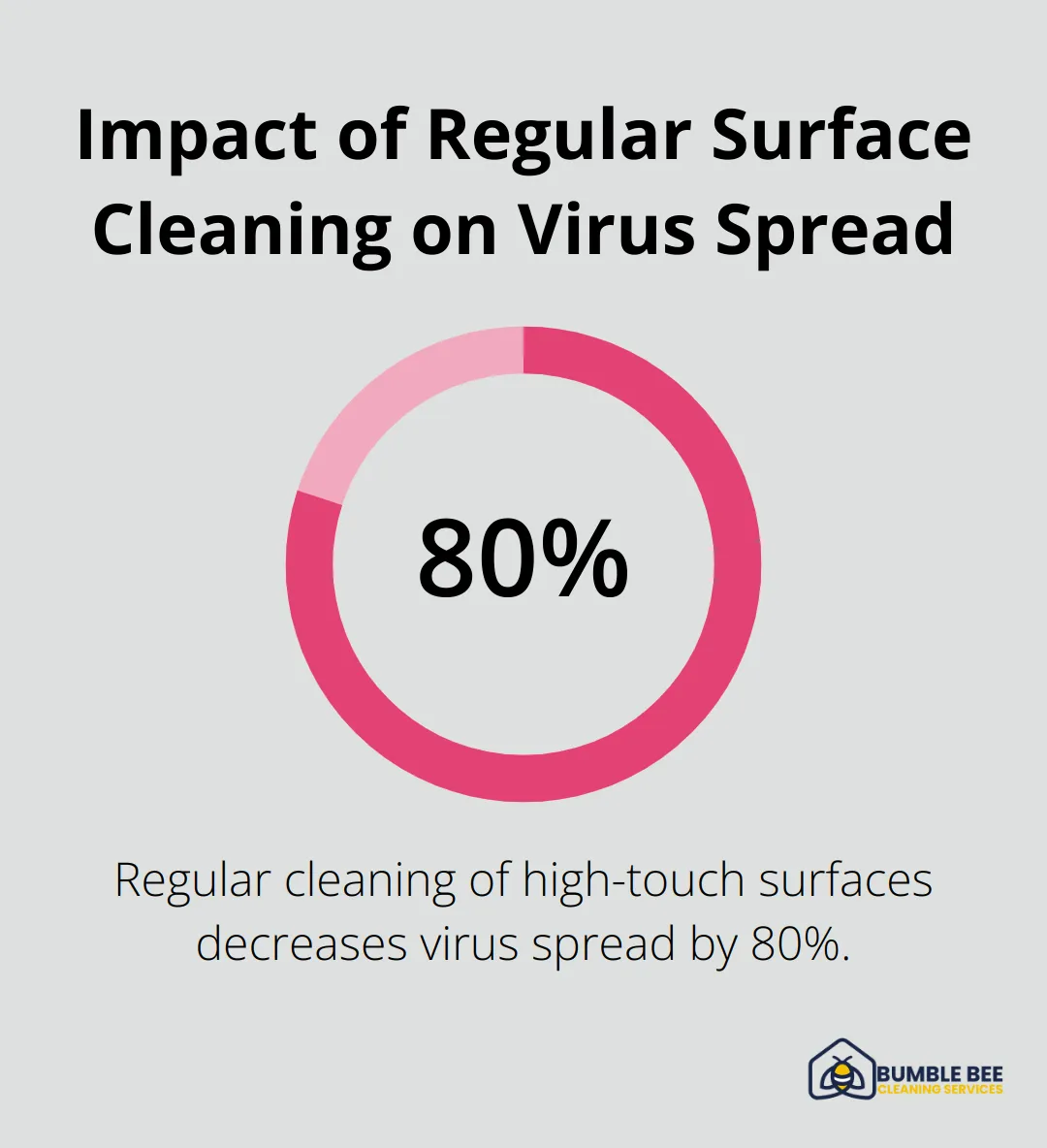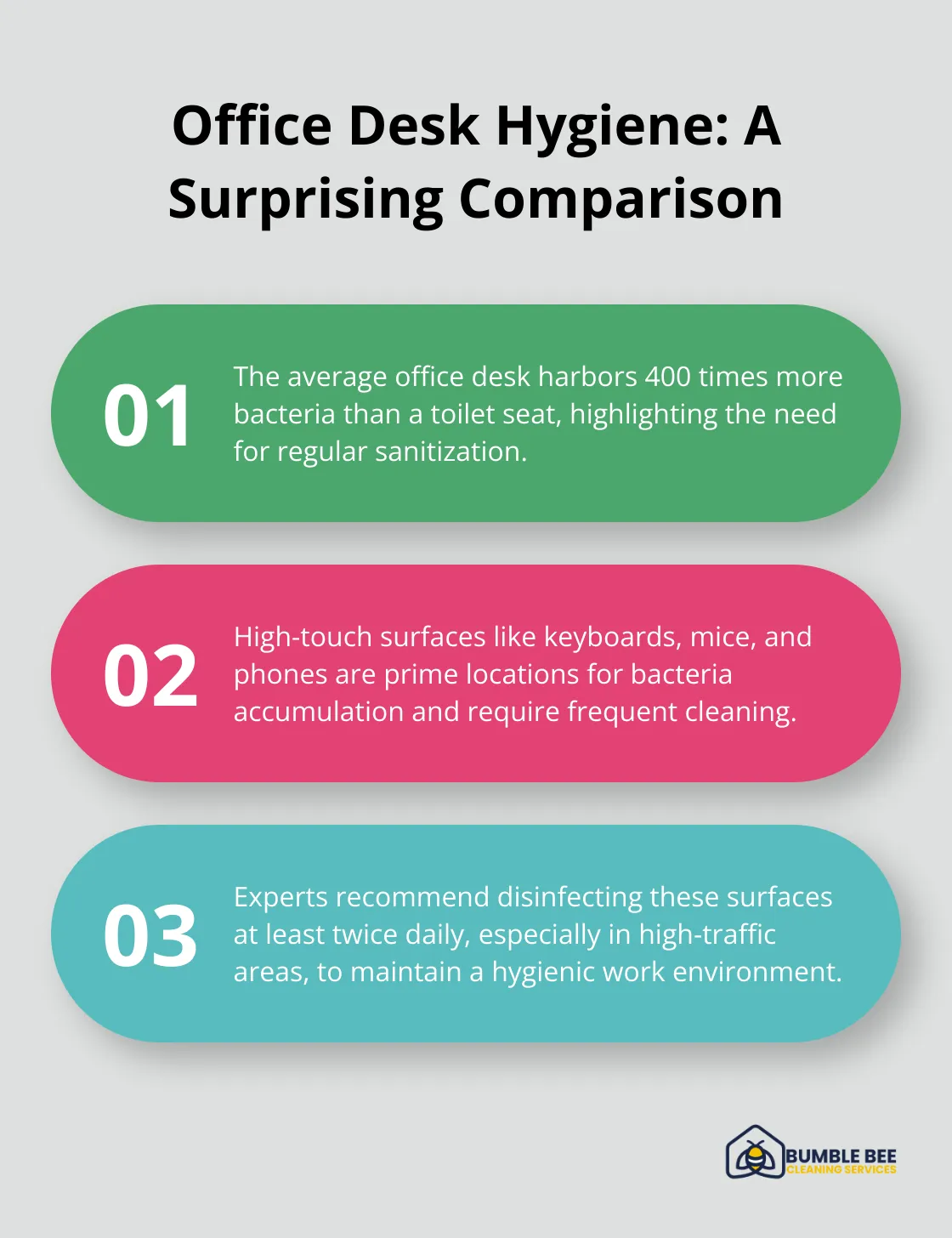At Bumble Bee Cleaning Services, we know that a clean workplace is more than just aesthetics. It’s a cornerstone of employee health and productivity.
In 2025, office sanitization has become a top priority for businesses looking to create healthier work environments. This blog post will explore how professional commercial cleaning can significantly impact your workplace’s well-being and your bottom line.
How a Clean Workplace Enhances Employee Health
Reduced Sick Days, Increased Productivity
A clean office environment directly impacts employee health and productivity. The University of Arizona conducted a study which revealed that regular cleaning of high-touch surfaces can decrease virus spread by up to 80%. This reduction translates to fewer sick days among employees. Companies that invest in professional cleaning services often observe a 2-8% decrease in employee absenteeism (a significant improvement in workforce availability).

Improved Air Quality for Better Breathing
Air quality plays a vital role in workplace health. Office spaces can accumulate dust, allergens, and pollutants, which may lead to respiratory issues. Regular deep cleaning of carpets, upholstery, and air ducts significantly enhances indoor air quality. Addressing this issue helps employees experience fewer allergy symptoms and respiratory problems.
Mental Clarity in a Tidy Space
A clean and organized workspace positively affects mental health. Research from the Princeton University Neuroscience Institute found that clutter can significantly distract employees and reduce their ability to focus. Professional cleaning services not only sanitize but also help organize workspaces. This organization leads to lower stress levels and improved concentration among employees.
Healthier Surfaces, Happier Employees
High-touch surfaces in offices (such as doorknobs, elevator buttons, and shared equipment) can harbor harmful bacteria and viruses. Regular sanitization of these areas reduces the risk of illness transmission. Employees feel more confident and comfortable in a visibly clean environment, which contributes to overall job satisfaction and well-being.
Long-term Health Benefits
Consistent workplace cleanliness provides long-term health benefits for employees. It reduces exposure to harmful substances, minimizes the risk of chronic respiratory conditions, and creates a more pleasant work environment. This investment in employee health can lead to increased loyalty, reduced turnover, and a more positive company culture.
As we explore the key areas to focus on for creating a healthier workplace environment, it’s important to understand how professional cleaning services can target these specific zones effectively.
Where Should You Focus Your Cleaning Efforts?
High-Touch Surfaces: The Germ Hotspots
High-touch surfaces serve as breeding grounds for bacteria and viruses. A study by the University of Arizona found that the average office desk harbors 400 times more bacteria than a toilet seat. This alarming fact emphasizes the need for regular sanitization of items such as keyboards, mice, phones, and doorknobs.
Experts recommend disinfecting these surfaces at least twice daily, particularly in high-traffic areas. The use of EPA-approved disinfectants can eliminate up to 99.9% of germs (a significant reduction in the risk of illness transmission among employees).

Air Quality: The Invisible Health Factor
Poor air quality can cause various health issues, ranging from allergies to severe respiratory problems. Most pollutants affecting indoor air quality come from sources inside buildings, although some originate outdoors. This underscores the importance of proper ventilation and air duct maintenance.
Regular cleaning of air ducts removes accumulated dust, mold, and other allergens. Professional air duct cleaning should occur at least once a year. This practice not only enhances air quality but can also boost HVAC efficiency by up to 40% (according to the National Air Duct Cleaners Association).
Carpets and Upholstery: The Hidden Reservoirs
Carpets and upholstery function as filters, trapping dust, allergens, and bacteria. However, they can quickly become saturated and turn into reservoirs of pollutants. The Institute of Inspection Cleaning and Restoration Certification (IICRC) advises professional carpet cleaning at least once every 12 to 18 months.
High-traffic areas may require more frequent cleaning. Deep cleaning of carpets and upholstery not only removes visible dirt but also extracts deeply embedded pollutants, which significantly improves indoor air quality and reduces allergens in the workplace.
Restrooms: A Critical Hygiene Zone
Restrooms require special attention in any cleaning regimen. These areas can harbor numerous harmful bacteria and viruses if not properly maintained. Daily cleaning and disinfection of all surfaces, including toilets, sinks, and door handles, is essential.
The use of color-coded cleaning materials (e.g., different colored cloths for different areas) can prevent cross-contamination. Regular restocking of soap, paper towels, and other hygiene products also plays a crucial role in maintaining a healthy workplace.
Break Rooms and Kitchens: Shared Spaces, Shared Responsibility
Break rooms and kitchens are common areas where employees gather, eat, and prepare food. These spaces can quickly become hotspots for germ transmission if not properly cleaned. Daily sanitization of countertops, tables, and appliances is necessary to maintain hygiene.
Encourage employees to clean up after themselves and provide easily accessible cleaning supplies. Regular deep cleaning of refrigerators, microwaves, and coffee machines will further enhance the overall cleanliness and health of these shared spaces.
As we shift our focus to the next chapter, we’ll explore how professional commercial cleaning techniques can elevate these efforts, creating an even healthier workplace environment.
How Professional Cleaners Create Healthier Workplaces
Professional cleaning services transform workplaces into healthier environments through advanced techniques. This approach combines eco-friendly products, cutting-edge technology, and strategic scheduling to maximize cleanliness and minimize health risks.
Eco-Friendly Cleaning for Healthier Air
Professional cleaners prioritize the use of non-toxic, environmentally friendly cleaning products. These solutions effectively remove dirt and germs without introducing harmful chemicals into the workplace. Improve indoor air quality through source control, ventilation, and filtration, which can reduce exposure to indoor pollutants. Green cleaning products contribute to this effort, potentially reducing the risk of respiratory issues and allergic reactions among employees.
The eco-friendly approach extends beyond surface cleaning. Professional services use HEPA filter vacuums that capture 99.97% of particles as small as 0.3 microns (a significant reduction in airborne allergens and dust). This level of filtration particularly benefits employees with allergies or asthma.

Advanced Technologies for Deep Sanitization
Modern cleaning technologies play a key role in creating healthier workspaces. Electrostatic sprayers apply disinfectants evenly across surfaces. This technology ensures that even hard-to-reach areas receive thorough coverage, which provides a more comprehensive clean than traditional methods.
UV-C light sanitization is another advanced technique, particularly effective in high-touch areas. This method uses ultraviolet light to destroy the DNA of bacteria, viruses, and other pathogens, which leaves surfaces sanitized without the use of chemicals. Studies show that UV-C light can reduce harmful microorganisms by up to 99.9% on exposed surfaces.
Strategic Scheduling for Consistent Cleanliness
A healthy workplace requires more than occasional deep cleans. Professional cleaning services implement regular sanitization schedules tailored to each workplace’s specific needs. High-traffic areas and frequently touched surfaces receive daily attention, while deeper cleaning tasks occur weekly or monthly.
A data-driven approach allows cleaners to identify peak usage times and adjust cleaning schedules accordingly. This ensures minimal disruption to business operations while maintaining optimal cleanliness levels throughout the day.
Professional services provide real-time cleaning logs and quality assurance checks. This transparency allows businesses to track the cleanliness of their workspace and make data-informed decisions about their cleaning needs.
Specialized Equipment for Different Surfaces
Professional cleaners use specialized equipment designed for different surfaces and materials. For example, they employ low-moisture carpet cleaning systems that deep clean without over-wetting (which can lead to mold growth). They also use microfiber mops and cloths that trap more dirt and bacteria than traditional cleaning tools.
Training and Expertise
Professional cleaning staff undergo rigorous training in the latest cleaning techniques and safety protocols. This expertise ensures that they can handle a wide range of cleaning challenges effectively and safely. They stay updated on the latest industry standards and best practices, which allows them to provide the highest level of service. The Cleaning Management Institute (CMI) offers comprehensive training programs that provide the knowledge and skills necessary for a rewarding career in the cleaning industry.
Final Thoughts
Professional cleaning creates healthier workplaces and improves employee well-being and business success. A clean environment reduces sick days, enhances air quality, and increases productivity. Employees in sanitized spaces report higher job satisfaction, better focus, and improved health, which leads to fewer absences and higher retention rates.
The long-term savings from professional cleaning outweigh the initial costs. Reduced absenteeism, increased productivity, and lower healthcare costs contribute to a healthier financial outlook for businesses. Office sanitization also extends the life of equipment and furnishings, which further reduces replacement and repair expenses.
We at Bumble Bee Cleaning Services understand the importance of office sanitization in creating healthier work environments. Our team uses eco-friendly products and advanced techniques to deliver exceptional results. To learn more about how we can help transform your workspace, visit our website for comprehensive cleaning solutions.
